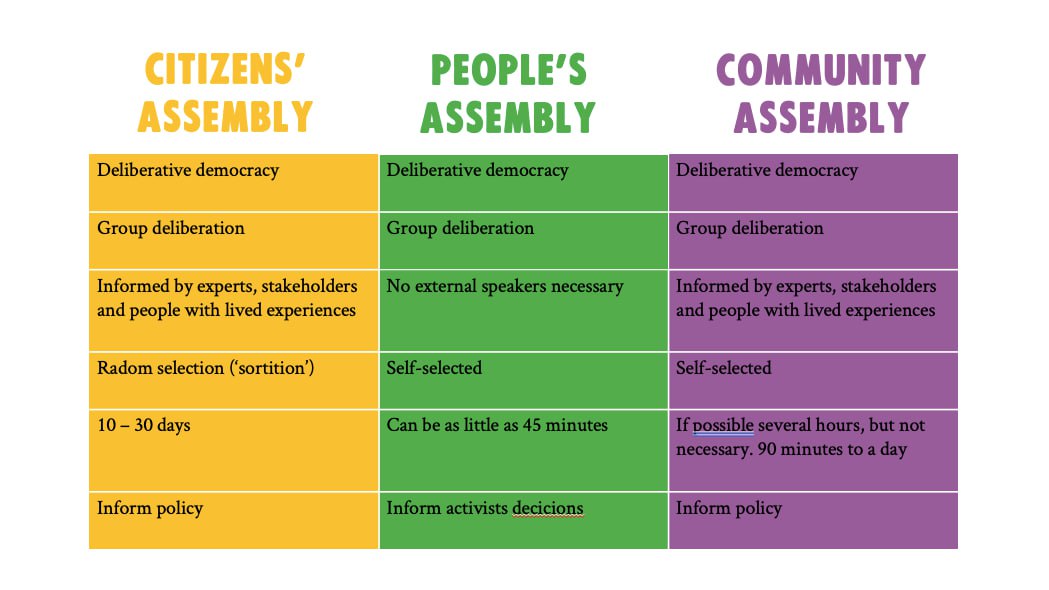What are People's Assemblies?
Why do we use People's Assemblies?
People’s assemblies are a structured way for a group of people to discuss issues or make decisions collectively, so that all voices are heard and valued equally, and no one person or group dominates the discussion.
Extinction Rebellion uses participatory democracy processes, such as people’s assemblies, in order to model participatory democracy within the movement, generate ideas, gather feedback and make decisions.
People’s assemblies have a very different purpose, structure and process to citizens’ assemblies, which is the central idea in our third demand in the UK.
This grass roots method of self-organising and direct action is genuinely democratic has been used throughout history to instigate people-powered change. People’s Assemblies were at the centre of the Arab Revolt that spread from Tunisia to Egypt in 2011, as well as the Spanish 15M movement, the Occupy movement, and the Y En A Marre movement in Senegal, and they are central to the organisation of the Democratic Federation of Northern Syria.
The third XR demand - the use of Citizens’ Assemblies chosen by Sortition - shows one way that our broken, political system can be made obsolete. Using Citizens’ Assemblies, we trust ordinary people, who are chosen at random and take part in a deliberative democratic process, to address the realities of the climate emergency in a way that those in power have failed to do and can never do. People’s Assemblies and Community Assemblies offer other ways for us to transform our democracy – they offer a way of seeing democracy in action out on the streets or in a community and help people reclaim power.
Both Citizens’, Community and People’s assemblies are based on the ‘assembly’ process which enables people to share equally and openly within an environment that is non-judgemental and respectful - and facilitated to that effect.
As the world becomes more and more atomized, meeting with strangers and sharing your feelings is itself transformative. In the context of Extinction Rebellion, assemblies are constructed in a way where people are safe to share their experience, make decisions collectively and work together to problem solve, as well as share the grief and loss they feel for a world that is rapidly collapsing.
The assemblies hold that grief with respect, and allow people to work together to organise towards rebellion and a shift away from the system that has brought us to this crisis of all crises. Assemblies are not an alternative to non-violent direct action, they complement such action and can themselves be a form of direct action if they are being held in a space designed to be disruptive or during occupations.
Within Extinction Rebellion assemblies have specific uses which these pages will explain. Assemblies are not an alternative to non violent direct action but they will complement that process. We continue with peaceful civil disobedience at the centre of all we do. People’s Assemblies can be part of the deep adaptation that communities have to go through in order to face the growing impact of climate and biodiversity breakdown. As societal structures collapse, we are going to have to reclaim power for our communities and these forms of participatory democracy will become essential to the way we organise.
How can People's Assemblies be used?
-
Movement BuildingAssemblies held in public spaces can act as a way for members of the public to be drawn into joining the conversation and add their voice to discussion and debate around the climate emergency or around specific topics such as local environmental issues
Assemblies can form part of a direct action when they are held during occupations, roadblocks or other forms of peaceful civil disobedience involving groups of people holding spaces any length of time-
Organising and Decision Making
Groups of any size can meet and discuss issues or make decisions collectively in regards to moving the aims and actions of an XR group forward. The basic participatory democracy method can be used by direct action groups, regional groups, affinity and working groups or community groups to make emergency decisions or for decisions on how to organise themselves.
The Three Pillars of People's Assemblies
-
Radical Inclusivity
Effective assemblies achieve radical inclusivity, where the emphasis on all being heard and valued equally means no voices are dominating and the collective wisdom of the assembly can be reached. People can participate safely and openly, without fear of judgement or ridicule. Radical inclusivity is a practical step to widening a movement through providing agency to all who participate. Radical Inclusivity also means being aware of potential barriers to engagement and working with those affected to enable participation. Think about disabled access, sign language, whisper interpretation for those for whom English isn’t their first language and other possible means by which those barriers can be removed. Ask if there are any barriers to engagement that people need to identify and then request that the group works together to find ways to remove them. -
Active Listening
Active listening is focusing on hearing people before developing a response in your mind whilst someone is still talking. Active listening is vital as it enhances our capacity to empathise; when we fully listen to others, we gain more of an understanding of people, their views and their concerns. -
Trust
Once the process for a people’s assembly has been agreed, it is essential that participants trust the process and trust the facilitators. The facilitators enable this trust by sticking to the agreed process and ensuring that everyone follows too. It is not meant to be a perfect system and can only be effective if people trust that those involved have come together in humility, to work towards decisions and actions that are best for all.
Diversity in opinion will pay you back in the long run socially… if we don’t fix this problem to start with we are simply going to replicate existing power structures
Eleanor Saitta, hacker and designer

